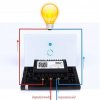upstatemike
Senior Member
This is getting a little complex. Can't I just have some DIP switches to set and skip all the master controller/secondary controller stuff? :blink:
Primary > Secondary controller replication for a main system used to be the standard many years ago and this was usually accomplished by walking around with a laptop. However, this method is definitely old school tech at this point. If you're using a HomeSeer system, the preferred method is to attach the Z-Wave interface to your system and simply use Z-Tool+ on your phone to set up the network. With this method, the interface attached to your main system is the primary controller, so you can leverage all the nifty Z-Wave features (like network wide inclusion and optimization and Z-Wave network backup and restore) from your main system. If you didn't get a chance to watch the video I (unsuccessfully) linked to on the previous page, give that a watch. It's really straightforward.upstatemike said:This is getting a little complex. Can't I just have some DIP switches to set and skip all the master controller/secondary controller stuff? :blink:
upstatemike said:This is getting a little complex. Can't I just have some DIP switches to set and skip all the master controller/secondary controller stuff? :blink:
We were the first controller company to support Z-Wave going back to 2003. For us, it has been a priority and there have been tremendous improvements over the years. I highly recommend it and would be happy to pit our products (especially our newest lighting products) against anything out there.Dean Roddey said:Still, for us, Z-Wave is not a main priority, so we don't have any interest in doing all the work required to become a master controller. Z-Wave is a low end consumer system that we don't recommend using as a main lighting system.
pete_c said:Personally waiting and already seeing the beginning of a modular ultimate smart switch
1 - modular front end - on and off and dim analog will function as a regular switch - toggle or decora style - led or non led illuminated
2 - miniature computer back end - low voltage network connection - wired and wireless - plug in module
3 - programmable such that it functions on it's own schedule or a connection to a master controller
4 - multiple function module - high voltage switching, low voltage sensors, tiny PIR, night and dark sensor, voltage and amperage draw et al.
5 - multiple automation protocal use - modular powerline, Z-Wave, Zigbee,WiFi*
current tinkering here lets me talk to a switch via the wire (serial-3 wires) or WiFi. Flash programming is 1Mb or less. You can now too expand flash beyond 1Mb same said footprint.
Radio modules these days are approaching thumbnail size...(wifi, Zigbee, Insteon and ZWave).
Back of switch footprint would have to fit conventional electical boxes width and depth.
I recall now posting here on Cocoontech or Homeseer about a father son tinkerer in Australia doing their own lighting switches using arduinos many many years ago. The issues brought up at the time related to the mixture of low voltage and high voltage switching (saftey) and sensors behind a conventional wall switch.


macromark said:We were the first controller company to support Z-Wave going back to 2003. For us, it has been a priority and there have been tremendous improvements over the years. I highly recommend it and would be happy to pit our products (especially our newest lighting products) against anything out there.
FWIW: Z-Wave "SmartStart" tech is on the way and our latest products are being shipped with Z-Wave "DSK" numbers (unique IDs) in a QR code format. So, it will eventually be possible to initiate inclusion by scanning products and powering them up.
upstatemike said:I don't think there is currently any lighting technology that is optimal far all use cases.
I have a bunch of Yale locks, but the newer Z-Wave Plus module is only for the Assure locks, not for the original. How did you plan to upgrade it?macromark said:The ONLY problem device is my older Yale door lock and I'm going to upgrade the Z-Wave module to Z-Wave Plus in a week or so. That should fix that. Everything else is rock solid.
